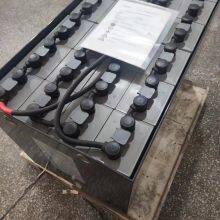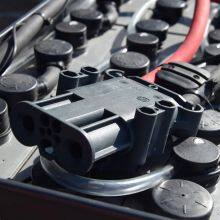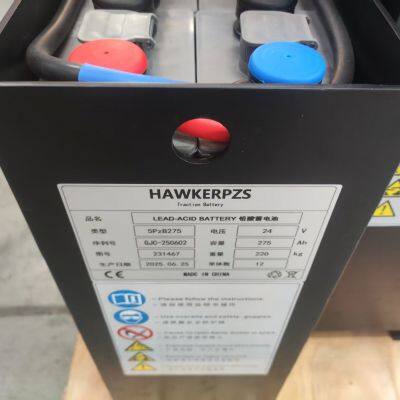VGD700 Komatsu Forklift FB25/2.5-ton Battery 48V High Configuration Japanese Komatsu Forklift Battery Installation Diagram
Applicable models: Komatsu forklift FB25 Voltage (V): 48 Capacity (Ah): 700 Iron box specifications (mm): 980 * 845 * 465 Battery type: Lead acid battery Unit quantity (only): 24
Knowledge of battery maintenance and upkeep for electric forklifts
1. The discharge capacity of a battery is expressed in terms of a 5-hour rate, and its capacity varies with the discharge conditions (discharge current, battery temperature, electrolyte density). High discharge current and short usage time; Low discharge current and long usage time.
2. Avoid overdischarging and overcharging; Overdischarging refers to the situation where the voltage of a single battery is below 1.7V and the electrolyte density is below 1.14g/cm3, making it difficult to recover to the optimal state through charging. Overcharging refers to charging a single battery to a voltage higher than 2.6V, with an electrolyte density of 1.28g/cm3, and maintaining it unchanged for 2-3 hours before continuing to charge. The temperature rise of the electrolyte will be too high, leading to aging of the electrode plate and separator. Overcharging and over discharging will shorten the service life of the battery.
3. When charging, be sure to open the cover box of the battery pack and keep it in a well ventilated environment. If the electrolyte temperature exceeds 55 ℃ during charging, the charging must be stopped or the charging current must be reduced.
4. Smoking and placing metal products on batteries are strictly prohibited; Batteries can produce explosive hydrogen gas. If metal products are placed, it can cause short circuit faults and sparks. Hydrogen gas can explode when exposed to fire and must be kept away from sources of ignition.
5. Keep the surface of the battery clean. There is a small amount of residual liquid on the battery cover during charging and discharging, which can cause micro short circuits and shorten the battery's usage time and reduce charging efficiency. When cleaning the surface of the battery, it is strictly prohibited for wastewater to enter the interior of the battery.
6. The density of the electrolyte decreases during discharge and increases during charging. If the electrolyte naturally decreases during use, pure water should be refilled to maintain the specified liquid level height (do not add dilute sulfuric acid); Only when the electrolyte overflows can dilute sulfuric acid of the same density be added, and it is strictly prohibited for impurities to enter the interior of the battery.
7. Prevent electrode plate vulcanization. During the use and storage of batteries, electrode plate vulcanization may occur, and its capacity will decrease. In the case of shutdown, the battery pack should be charged normally every 20 days. Under normal use, balanced charging should be performed once a month to eliminate voltage unevenness among individual batteries in the entire group. It is strictly prohibited to not recharge the batteries in a timely manner after use.

Send Inquiry to This Supplier
You May Also Like
-
Hawker Batteries | Hawker Battery (China) Sales Headquarters (UK)US$ 1 - 200MOQ: 1 Carton
-
Hawk's Easy-to-move Forklift Battery 24V8PZB560, Heli Electric Traction Power Battery for Underground Mining VehiclesUS$ 18000 - 18500MOQ: 1 Bag
-
LindlindeL12 Electric Pallet Battery 2PzB200/24V200ah Hawker Forklift BatteryUS$ 1000 - 1100MOQ: 1 Bag
-
German Silver Cedar Battery, German SILVERFIR, Silver Cedar Battery - China Official WebsiteUS$ 180 - 200MOQ: 1 Bag
-
African 8PZS920 Forklift Battery 48V920Ah Electric Flatbed Traction Battery Pack VENTURAUS$ 4810 - 4850MOQ: 1 Bag
-
VENTURA FP25H1C Aviation Battery 1.2V25AH American Aviation Power Supply 20FP25H1C-R HelicopterUS$ 480 - 500MOQ: 1 Bag
-
VENTURA FP22H1C Aviation Battery 1.2V22AH American Aviation Power Supply 20FP22H1C-R HelicopterUS$ 480 - 500MOQ: 20 Bags
-
HAWKER 4PzV440 96V440AhForklift Battery Warranty for Two YearsUS$ 4500 - 5000MOQ: 1 Bag
-
HAWKER LiFePO4 EV24-60 AGV Safe BatteryUS$ 900 - 1000MOQ: 1 Bag
-
HAWKER Battery 5PZS575 48V575Ah Linde E16C Warranty for Two YearsUS$ 4500 - 5000MOQ: 1 Bag



















